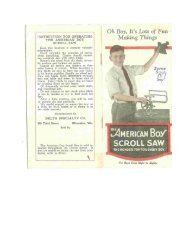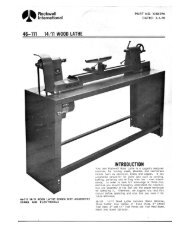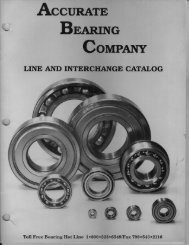Create successful ePaper yourself
Turn your PDF publications into a flip-book with our unique Google optimized e-Paper software.
After marking each end, the true center should be dOefinitely<br />
marked with a punch aw I or dividers, as shown<br />
in Fig. 41. If the stock is hardwood, the centers should<br />
be drilled to a depth of about 1/8", as shown in Fig. 42.<br />
The spur or live center is then placed against one end<br />
of the wcrk and seated by striking with a mallet, as<br />
shown in Fig. 43. In hardwood, it is advisable to make<br />
a starting seat for the spur center, this being done by<br />
sawing on the diagonal lines, as shown in Fig. 44,<br />
and drilling a small hole at the intersection. After<br />
driving the center, it is best to hold center and work<br />
together and fit immediately to headstock spindle.<br />
If you are not using a baII beari ng center the end of<br />
work at tai Istock center should be oi led, placing the<br />
lubricant on the wood either before or after it is put<br />
in the lathe, see Fig. 45. Many turners use beeswax,<br />
tallow, or a wax-and-oil mixture as a lubricant. The<br />
ideal method is to use a ball bearing center, which<br />
eliminates lubricating entirely. If the work is to be<br />
removed from the lathe before completion, an index<br />
mark should be made as a guide for recentering, as<br />
shown in Fig. 46. A permanent indexer can be made<br />
by grinding off one corner of one of the spurs.<br />
USE A<br />
MALLET TO<br />
SET CENTER 11IIIII<br />
Fig. 43<br />
ALSO."<br />
SAW,<br />
DIA60NALS<br />
1=012<br />
LiVE<br />
c.eNTE~<br />
Fig.44<br />
TOOL REST POSITION. The tool rest is now mounted<br />
in place, about 1/8" away from the work and 1/8"<br />
above the work centerline, as shown in Fig. 47. This<br />
position may be varied to suit the work and the operator.<br />
A guide mark to show the most suitable working position<br />
can be placed on the tool rest shank as an aid to<br />
quick and accurate re-setting. Once some experience<br />
has been obtained, the setting of the tool rest will<br />
become almost second-nature.<br />
MARK<br />
CENTER<br />
WITH<br />
DIVIDERS<br />
(<br />
HARD<br />
STOC.K l.;;f<br />
Fig. 41 Fig. 42<br />
MARK<br />
THE<br />
WORK<br />
FOR RE-<br />
CENTERIN<br />
Fig. 45 Fig 46<br />
MOUNTING. Mounting the work is done by moving the<br />
tailstock up to a position about 1 or 11/2" fran the end<br />
of the stock, and locking it in this position. Advance<br />
the tai Istock center by turning the feed handle unti I<br />
the center makes contact with the work. Continue to<br />
advance the center whi Ie slowly rotating the work by<br />
hand. After it becomes difficult to turn the work, slack<br />
off on the feed aoout one-quarter turn and lock the<br />
tai Istock spindle.<br />
14<br />
DRILL<br />
CENTER<br />
IF WORK<br />
IS HARD<br />
WOO~<br />
I<br />
I<br />
I<br />
/<br />
..








